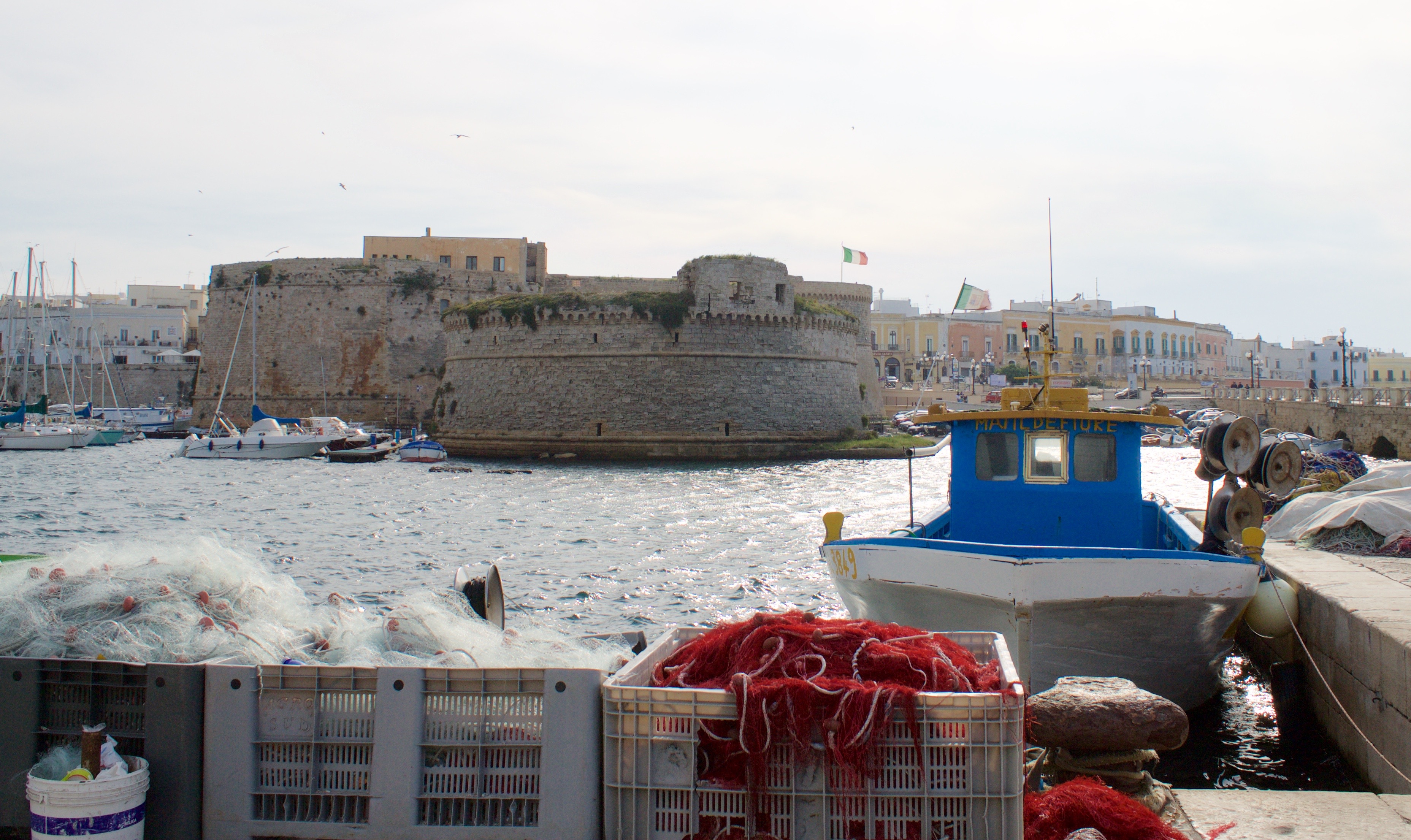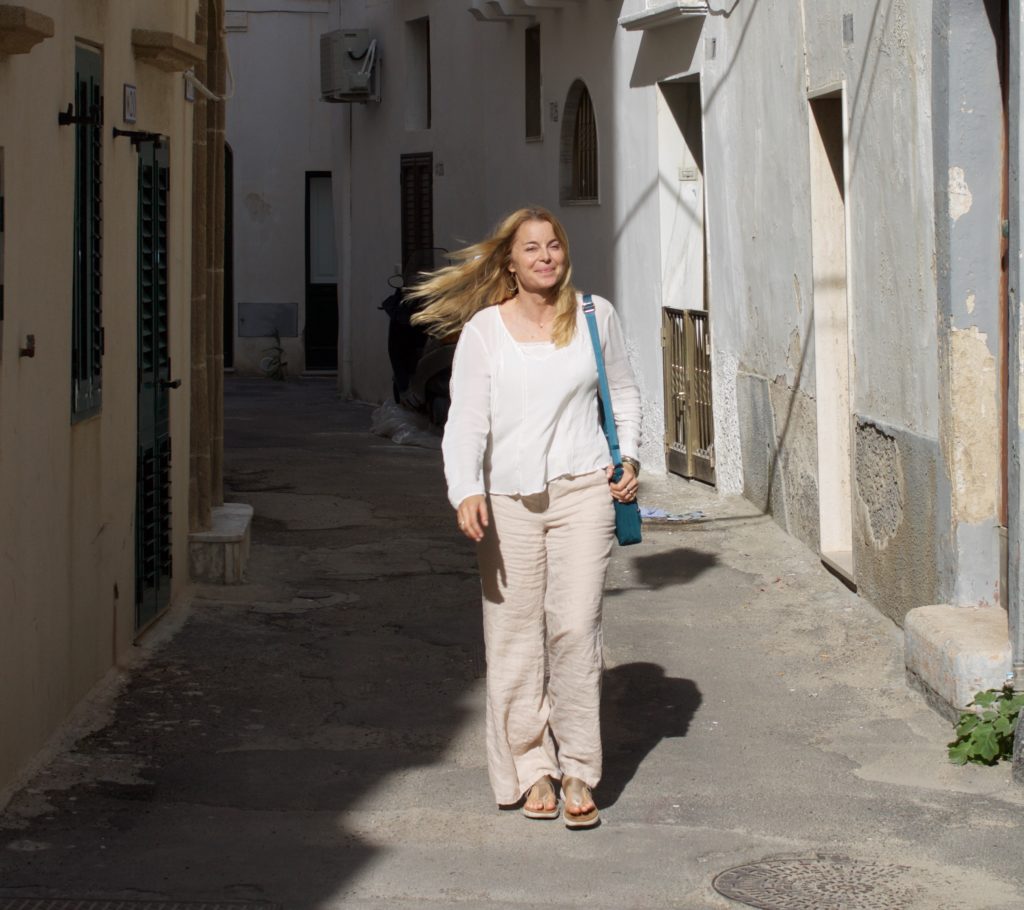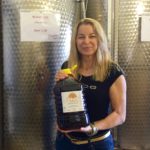“Era considerato l’oro verde,” (It was considered green gold,) Marco says as we leave the whitewashed light of the via, and take a tunnel-like stairway down to a cave under the street.
I’m in Gallipoli, on the Ionian coast of Puglia, with Italian friends. This area was once part of Magna Grecia (greater Greece,) and Gallipoli’s Greek name was Kallí Pólis (beautiful city.)

The temperature drops perceptibly as we enter the cavernous room hollowed from tufa rock. This is a “Frantoio Ipogeo,” an underground olive press.
I recognize the large millstone with the circle around it which donkeys would have walked, but I still didn’t know why all this is underground. Then a guide appears in the darkened room and asks if we’re Italian. “Si,” my two friends say, and then mention that I’m American.
“Oh, I don’t speak English,” the guide says with widened eyes.
“Neither do we,” my two friends say. “She understands well, no worries,” they add, with an indication toward me.
Her explanation is essential as I had no idea about the lamp oil.
It turns out, Gallipoli was the primary producer of oil for lamps in the 17th and 18th centuries. This olive oil, from olives that were more mature than the ones for the consumable olive oil, is called olio lampada. The olives in the Gallipoli area were particularly good for creating a lamp oil that produced no smoke when burned.
“The workers stayed down here from fall to spring.” The guide says, waving toward the ticket booth where the workers had slept. There are little stalls too, for the donkeys, that are carved into the tufa rock, reminding me of biblical manger scenes.
There were about 60 of these oil presses underneath the town. The wealthy families had their own personal one under their palazzo. Why underground? Because the cooler air made it easy for the oil and water during production to separate from each other. And this way it was easier to protect their “Green gold” from the invaders– who arrived frequently by sea.
“It was a boom time. Gallipoli became wealthy from the olio lampada. It was shipped as far as England and Russia,” the guide goes on to explain.

The shipping was all done by sea and the barrel makers (for barrels to contain the oil) also enjoyed a booming business.
Due to the importance of this business, vice consuls from all over Europe took up residence in Gallipoli.
Then came the bust in the form of industrial revolution when the drilling for crude oil began.
“They lost their jobs and immigrated,” the guide says.
I think of the shock and then of the process of resignation that the workers must have experienced as they dealt with their fate and decided to immigrate.

We amble over to the outdoor fish market that we spied not far from where we parked. We have a hunch that the fish market with its displays of fresh mussels, oysters, squid and shrimp, is a good place for lunch.
We take an outdoor table at one of the eateries in the small market and instead of ordering primi and secondi we suggest get a spread of antipasti.
It’s the best seafood I’ve yet had on this trip. The broth of the mussels is so good I gleefully do the “scarpetta” (wiping the platter with bread.)

The squid are incredibly tender and the anchovies particularly delicious. My friends say the anchovies would have been marinated for 12 hours in salt, then 12 hours in vinegar and lemon. The house white wine is light and simple but just buzzy enough to add an extra spark to the afternoon.

Before we leave, we check out the cathedral, dedicated to Saint Agata. “Stupendo!” Marco repeats over and over as we wander under a decorated roof that’s as high as the clouds. The gigantic paintings are all baroque from the 17th century as far as I can ascertain.
Perhaps most charming is that Marco brings his dog Zach into the church and no one minds at all.
Visiting:
The Frantoio Ipogeo is in Via A. de Pace and is open mornings until 1:00, and again in the afternoon starting at 4:00. On weekends it’s open only mornings until noon. In July and August it’s open nonstop from 10:00 to midnight.
The fish market appeared to open in the afternoon as well as the morning.
The cathedral’s opening hours vary, but mornings are the best bet.
From Lecce there’s a train line called Ferrovia del Sud Est that goes goes to Gallipoli but not on Sundays. It is easiest to arrive by car.
For where to eat in Lecce (a city not to miss when you’re in Puglia) go here and for the best gelato in Lecce go here





A fascinating area of Italy. The seafood looks fabulous and the history of olive oil is very interesting. A fabulous country for sure. Lin
Yes, such a fabulous country, the history and the things to discover go on and on.
Such interesting insights and photos,love hearing about these experiences!!
Thanks, glad you liked the photos and the story!
I would have loved to tour the underground olive presses; such fascinating history. It’s too bad that the lamp olive oil didn’t remain popular. I can’t imagine wanting to leave that area!
Tami, I hope you’ll be able to visit it someday!
It was fascinating to learn about the “Green Gold” and the history of the Lamp oil and its importance to Gallipoli. Thanks for this insightful piece of writig.
Glad you found it interesting, yes I thought it was quite fascinating too. 🙂
What a cool experience! I had no idea how olive oil was made, and a look back at the history and mechanics of this amazing product!
Hi Kevin, yes it is also fun to visit olive producing areas in November when they’re harvesting the olives and taking them to the presses… you can view the whole process.
Thank you for a real history lesson 🙂 Wish I had a plate of Italian seafood with me right now, it looks incredibly fresh and delicious!
You are welcome!
What a magnificent place! I am definitely adding Gallipoli to our travel list in Europe! And I totally lol’d when you were talking about the muscles and the broth being so good that you wiped the platter with bread. I’ve been known to order 3 loaves of bread to do the exact same thing 🙂 Glad I know the word for it now!
Ha ha! Yes, go back to Italy and “fare la scarpetta!”
Such a wonderful post. I am sure having a non-english speaker guide would be quite an experience, glad you understand Italian. Underground olive press seems quite interesting.
Glad you enjoyed the post!
So before the big players of oil suppliers and producers today, there was Gallipoli for oil lamps. Hehe. interestingindeed to know this kind of information and makes you realised how the world has been offering bulks of wonders
Such a cool post! I loved learning about the history of olive oil and your pictures are great!
Thanks Joe!